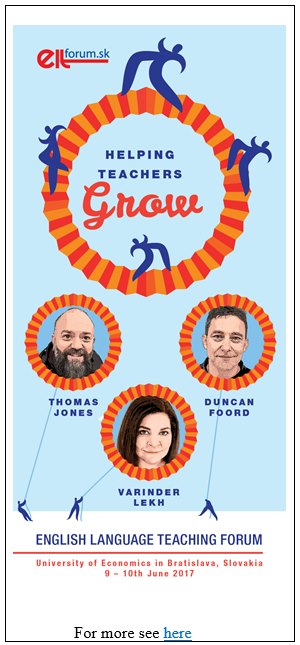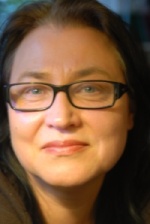Dear HLT Readers,
Welcome to the June issue of HLT. First some Pilgrims news. We hope to greet you in Canterbury on our summer teacher training courses held at the University of Kent, UK. There are many courses to choose from and it is not too late to book (for details see here). Perhaps we can meet in Bratislava, Slovakia during the ELT Forum, or some other upcoming events like, for example, IATEFL Poland in Bielsko-Biała.

There is also a new initiative that may be of great interest to you. If you've always wanted to publish your own ideas and you're brimming with ideas after your course at Pilgrims - we have the perfect FREE solution for you - to get your book with your ideas published! For more details read Pilgrims News: Ourboox.
The texts in this issue fall into three groups, which is reflected in the colour coded contents page. In the C Group section you can find C for Creativity: Selected Bonnie Tsai Scholarship Entries. Some time ago creative teachers could apply for the scholarship by sending in their creative ideas. Here are a few examples including the winning entry: Working on Feelings by Aphrodite Gkiouris, as well as The Bigger, the Better: Teaching With a Big Roll of Wrapping Paper by Margarita Kosior, and Head and Shoulders, Knees ... and More! by Alan Paradiž.
We are happy to let you know that you can win a further Bonnie Tsai Scholarship and enjoy a Pilgrims course in 2018 For details see below.

Details how to win the scholarship will be announced in the August issue of HLT.
The second group of articles (colour coded in blue) focuses on SDG in ELT - The Sustainable Development Goals, “otherwise known as the Global Goals, which are a universal call to action to end poverty, protect the planet and ensure that all people enjoy peace and prosperity”.

The texts include: The SDGs and Global Citizenship: Working with Public Servants in Myanmar (Burma) by Thomas Kral and Shannon Smith, Myanmar, Proposal for Connecting Creativity with the UN's 17 SDGs by Rebecca Taylor Al-Samaraie, Climate for Change: Role of Language Teachers by Harisimran S Sandhu, The Sea! The Sea! Sustainable Development Goal 14 in a CLIL Process by Judit Fehér, The Play’s the Thing by Nick Bilbrough, and Nature’s Grammar Talk: A Lesson on Graded Language Learning For IX/X Graders by N Shesha Prasad.

I would like to invite Alan Maley to introduce this section, give some background to the idea behind the texts, and explain why these texts are published together. Over to Alan…
The contributions in this section relate to the United Nations’ Sustainable Development Goals (SDGs), adopted by the UN in 2015 in response to the whole range of issues confronting humans on the planet . (A complete list of the goals can be found at: https://sustainabledevelopment.un.org/?menu=1300 In early 2016 the British Council invited Nik Peachey and me to co-edit a collection of papers focused on incorporating the SDGs into language teaching. This was to be a follow-up to the volume we had co-edited in 2015, titled Creativity in the English Language Classroom (still available as a free download from: via http://englishagenda.britishcouncil.org/continuing-professional-development/cpd-teacher-trainers/creativity-english-language-classroom). So in addition to placing the SDGs centre-stage, we were also looking for a creative take on them, in terms of creative inputs, processes and outcomes.
We received well over 100 proposals in response to our call for contributions. Given that we had space for only 22 chapters, there were some difficult decisions to make in arriving at a final selection. Many of the proposals which were not selected were nonetheless of high quality and merited publication. Knowing how disappointed some of those who had not been selected would be, we cast about for a possible alternative home for their contributions. We are grateful to Hania Kryszewska for having agreed to dedicate a special place for them in this issue of HLT Mag.
The papers which follow all have much to offer the practising teacher. They cover a wide range of geographical and pedagogical contexts. Taylor Al-Samaraie’s report on her pro-bono work with adult, immigrant, non-English speaking catering learners in Abu Dhabi highlights the importance of education in helping the underprivileged to liberate themselves. Myanmar provides the highly complex context for Kral and Smith’s report on communication skills training for public servants. All the SGDs are involved in this but the main focus is on SDG 4 Education and SDG 10 Reducing Inequalities. The authors emphasise the importance of going beyond awareness raising to personal and professional transformation. Bilbrough’s article makes an impassioned plea on behalf of children in Gaza, and by extension of underprivileged children everywhere. He describes ‘The Hands Up Project’, which focusses on using drama and story-telling both to promote English language teaching and to give these children a voice. He offers practical, creative activities for teachers who might wish to take this work forward in their own circumstances. Fehér, working in Hungary, sets out a detailed set of activities with a focus on the sea – sea water, life in seawater and plastic pollution of the sea. The visual and other material here offers teachers a rich resource. The same is true of Prasad’s article, describing her work in a secondary school in India. Her visual resources deserve special attention. Finally, Harisimran offers a detailed rationale for integrating SDGs into the curriculum and gives a detailed lesson plan relating to climate change, including worksheets and some very useful references to other resources.
So there is plenty of food for thought here and many practical suggestions. But you might well ask what the SDGs to do with language teaching. As we argued in the Introduction to the new British Council publication (see below for details).
“There are several intertwined answers to this question. A growing number of ELT professionals have come to believe that language teachers are more than just teachers of language. Through what they teach and their attitudes and practices they have an enduring influence on the future attitudes and personalities of their students. As John Dewey put it:
‘Perhaps the greatest of all pedagogical fallacies is the notion that a person learns only what he (or she) is studying at the time. Collateral learning in the way of the formation of enduring attitudes may be more important than the lesson in geography or history (or language! Eds’ italics) for these attitudes are fundamentally what count for the future.’
There can now be no room for doubt that planet earth is currently assailed by some potentially lethal problems. The scale of the impact of human intervention on the planet has recently been compared with previous geological periods – and given a name The Anthropocene (see references). The effect of massive industrial and technological expansion, combined with exponential population growth has put the survival of our ecosystems in jeopardy. Furthermore, as competition for control of resources increases, so too does the potential for conflict, with all its dire implications for humanity. Human impact has increased dramatically yet human nature has not made comparable progress. Many of our present woes are directly attributable to greed, pride, self-interest, prejudice, aggressivity, indifference to the plight of others, and the long list of the more negative characteristics of humanity.”
We can choose to be mere language teaching instructors or to develop as ‘transformational intellectuals’ (Vadivelu) and true educators.
(The new British Council publication is titled: Integrating global issues in the creative English language classroom: With reference to the United Nations Sustainable Development Goals, This is also freely downloadable from: http://englishagenda.britishcouncil.org/continuing-professional-development/)
Thank you Alan

As for the main body of this issue there is a wealth of texts which cover a variety of topics. They include: CLIL (Game-based Immersive Approach to EFL and CLIL: A Case Study by Letizia Cinganotto and How to teach Secondary Science by Catrin Green reviewed by Aleksandra Zaparucha), teaching advanced learners (Fiction to Film: Advanced ESL Students Translating Literary Form by David Charles Deller), using technology (Integrating Technology into Teaching: Technological Pedagogical Content Model (TPACK), and Its Implications by Mary Jane Özkurkudis), using the corpus (Using Parallel Corpora for Language Learning by Michael H. Brown, and using literature (Lesson Plan: The Birthmark by Refia Durmaz and Carol Griffiths).
Don’t miss the news from the publishing world: Teaching Grammar: From Rules to Reasons’. An Auto-review by Danny Norrington-Davies, Best of the Best. Progress eds. Isabella Wallace and Leah Kirkman, and The Lazy Teacher’s Handbook – New Edition.

Enjoy the June issue of HLT
Best greetings
Hania Kryszewska
HLT Editor
e-mail: hania.kryszewska@pilgrims.co.uk



|